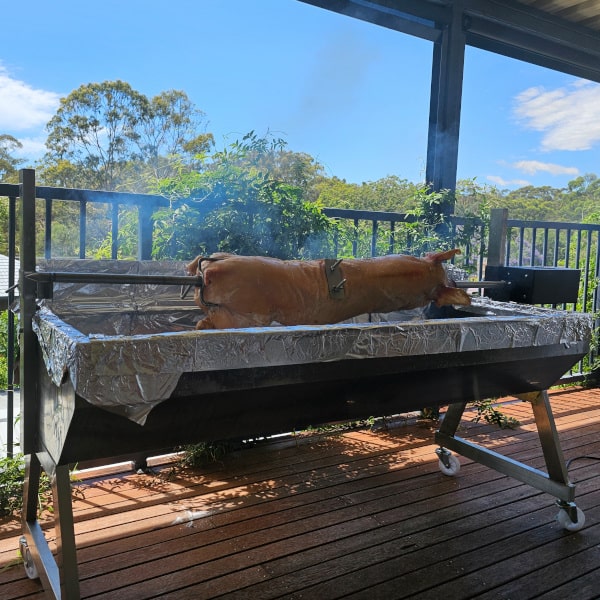
How to Clean and Maintain Rotisserie Equipment
Table of Contents
A good rotisserie setup delivers unbeatable flavour, but it only performs well if you look after it. Regular cleaning and basic maintenance make all the difference when it comes to cooking results, safety, and how long your gear lasts. Here’s a practical guide to keeping your rotisserie gear—motors, rods, baskets all running smoothly and ready for your next feast.

Know What You’re Working With
Before getting started, it helps to know the type of barbecue spit rotisserie you have. OLA stocks a range of gear, from basic single-rod units to heavy-duty 1500mm spit roasters with hoods and charcoal trays. Some run on charcoal, some on gas, and others are hybrids.
If you're new to it, our introduction to rotisseries guide covers the basics and can help you pick the right setup.

Cleaning Methods for Your Rotisserie Parts
There’s no need to overcomplicate it. Just break it down into the key parts:
-
Spit rods and prongs: These get greasy fast. Scrape off the big bits while still warm (but not hot), then soak in warm soapy water. Scrub with a stiff brush or non-scratch pad until clean.
-
Rotisserie baskets: These can be awkward to clean. Soak them as you would the rods, and pay attention to corners and hinges where gunk collects. If you’ve used them for sticky marinades or sauces, soak a bit longer.
-
Charcoal trays and drip trays: Empty ash and fat drippings after each cook. Brush out residue and wipe clean with a damp cloth. Don’t let ash sit—it’ll absorb moisture and promote rust.
-
Motors and electrical parts: Never submerge. Wipe the exterior with a dry or lightly damp cloth. Clear any debris from vents. Always unplug before cleaning.
A soft-bristle bottle brush or old toothbrush can help reach tight spots around brackets and bolts. For larger setups, it might be easier to clean outside using a hose and scrub brush, but dry everything completely afterward to prevent rust.

Routine Maintenance: Keep It Cooking Clean
After each use:
- Wipe down all surfaces while they’re still slightly warm.
- Scrape off any burnt bits or hardened fat.
- Remove any leftover ash or drippings.
Every few uses:
- Disassemble and soak the prongs, rods, and baskets.
- Check the motor mount and brackets for stability.
- Re-oil any moving parts that require lubrication.
Every few months:
- Give the full unit a deep clean.
- Inspect for signs of wear or corrosion.
- Replace any bent or damaged forks.
If you're rotating whole lambs, pigs, or large cuts, the extra fat needs clearing out before the next cook. Grease build-up can cause flare-ups or make your gear smell bad.

Cooking with Charcoal vs Gas on a Spit Roaster
So what's the difference between cooking with charcoal vs gas on a spit roaster? Charcoal gives you that rich, smoky flavour and traditional feel, but it can be messier and take longer to clean up. Gas is cleaner and faster, but doesn’t quite hit the same depth of flavour. Either way, regular maintenance helps both systems perform well—clean burners and clear ash mean better airflow and consistent temps.
Want to try something new? Add a barbecue smoker to your setup to switch between roasting and low-and-slow smoking.

Storage Tips That Make Gear Last Longer
- Store rods and accessories in a dry spot.
- Keep motors in a sealed tub or cupboard when not in use.
- Cover the entire setup if you leave it outside, especially during the off-season.
- Wipe everything down with a dry cloth before storing.
Don’t forget your outdoor setup might be exposed to rain, salt, or sun, depending on where you live. If you're using barbecues for caravans or a barbecue for boat setups, you’ll need to be extra mindful about rust and exposure. Salty air and moisture can take their toll, so consider a protective cover or relocating the gear inside when not in use.

Recommended Cleaning Products
Stick to warm, soapy water, degreasers rated for cooking gear, and non-scratch pads or brushes. Avoid steel wool—it can leave metal particles behind and scratch protective coatings. A spray bottle of vinegar and water works well as a post-cook wipedown to break down grease without harsh chemicals.
Some cleaning sprays contain natural enzymes that help dissolve fat and residue. These are great for food-contact areas, but double-check that they’re rated safe for BBQ use. For hard-to-reach areas, compressed air or a detail brush set can be a handy addition to your BBQ toolkit.

When It’s Time to Replace Parts
Even with the best care, some parts don’t last forever. If the rotisserie rod is warped, forks no longer grip, or your motor sounds like it’s struggling, swap them out. OLA stocks replacement parts for most spit sizes and motor types, so you can upgrade or refresh without buying a whole new unit.

Our Final Tips For Cleaning Your Rotisserie Equipment
Regular upkeep is a lot easier than dealing with stuck-on mess or broken gear just before a big cook. Set a rhythm: clean after every use, do a deep clean monthly, and give everything a proper once-over before long storage. Your gear will last longer, work better, and stay ready for the next celebration.
If you need help picking gear or getting replacement parts, our team’s happy to help. Explore our full range and get the most out of your next roast.



Leave a comment